

10 Tips for Writing. 1.
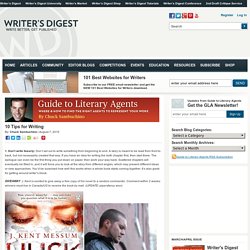
Don’t write linearly: Don’t set out to write something from beginning to end. A story is meant to be read from front to back, but not necessarily created that way. If you have an idea for writing the sixth chapter first, then start there. The epilogue can even be the first thing you put down on paper, then work your way back. Scattered chapters will eventually be filled in, and it will force you to look at the story from different angles, which may present different ideas or new approaches.
GIVEAWAY: J. Column by J. 2. 3. (Should you mention self-published books when querying an agent?) 4. 5. Want to build your visibility and sell more books? 6. 7. 6 Ways to Create Riveting Conflict in Your Story. Who says conflict is a bad thing?
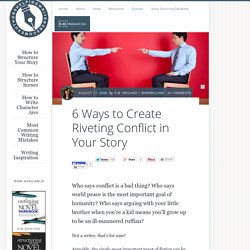
Who says world peace is the most important goal of humanity? Who says arguing with your little brother when you’re a kid means you’ll grow up to be an ill-mannered ruffian? Not a writer, that’s for sure! Arguably, the single most important tenet of fiction can be summed up in the saw “no conflict, no story.” How a Scene List Can Change Your Novel-Writing Life.
By the end of this post you will have a nagging urge to use an excel spreadsheet.
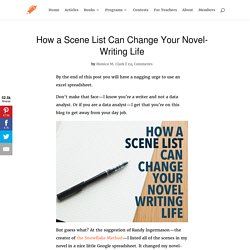
Don’t make that face—I know you’re a writer and not a data analyst. Or if you are a data analyst—I get that you’re on this blog to get away from your day job. But guess what? At the suggestion of Randy Ingermason—the creator of the Snowflake Method—I listed all of the scenes in my novel in a nice little Google spreadsheet. It changed my novel-writing life, and doing the same will change yours too. Creating a scene list changed my novel-writing life, and doing the same will change yours too. Easy Novel Outline – Free Writing Lessons and Worksheets. Here you'll find easy novel outline techniques to plan your book step by step, along with worksheets for planning characters and scenes.
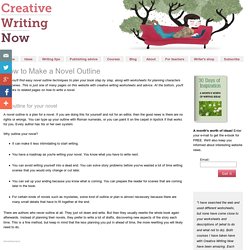
This is just one of many pages on this website with creative writing worksheets and advice. Easy Novel Outline – Free Writing Lessons and Worksheets. Easy Novel Outline – Free Writing Lessons and Worksheets. Creative Writing Prompts. How To Find Your Writing Muse. If you’re lying awake in bed, and you look over at your sleeping partner with their tongue hanging out, snoring, making odd farty noises, and your heart starts beating faster and you think, “Of course!
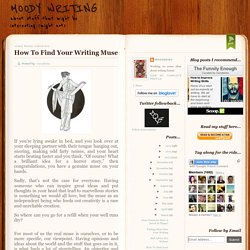
What a brilliant idea for a horror story,” then congratulations, you have a genuine muse on your hands. Sadly, that’s not the case for everyone. Having someone who can inspire great ideas and put thoughts in your head that lead to marvellous stories is something we would all love, but the muse as an independent being who feeds out creativity is a rare and unreliable creation. How to turn a high concept idea into an actual story. 5 Simple Rules For Turning Your Cool Idea Into A Screenplay. The 10 Types of Writers' Block (and How to Overcome Them) 8 Unstoppable Rules For Writing Killer Short Stories. The 7 Types of Short Story Opening, and How to Decide Which is Right for Your Story. How to Sell Readers on Your Story's Main Ideas in 4 Easy Steps.
How to Write a Sincere First Draft of Your Science Fiction or Fantasy Epic. 9 Joyful Ways to Demolish Your Favorite Genre. I'm sick of saving the world: The case for smaller-scale stories. How To Create A Killer Opening For Your Science Fiction Short Story. 10 Ways To Turn Your Real Life Experiences Into Science Fiction. 12 Secrets To Being A Super-Prolific Short-Story Writer. Stop Learning. Start Applying. — Personal Growth. Stop Learning.
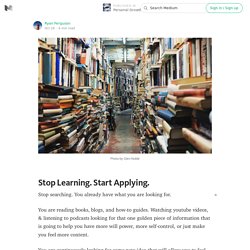
Start Applying. Stop searching. You already have what you are looking for. You are reading books, blogs, and how-to guides. Watching youtube videos, & listening to podcasts looking for that one golden piece of information that is going to help you have more will power, more self-control, or just make you feel more content. You are continuously looking for some new idea that will allow you to feel productive, happy, & satisfied, but you already have everything you need to be happy. Why is it so much easier to continue looking for new information instead of using what we already have? Maybe it is a by-product of the advertising of businesses telling us we always need more. Maybe it is a good distraction. Maybe, the root causes of our failure to apply our knowledge are painful emotions that are uncomfortable to deal with. Let me give you an example. I knew that Amanda wanted empathy.
The Difference Between a Great Story and a Shitty Story Is Often Really Tiny. How to Write a Novel Using the Snowflake Method. Writing to the Imagination. By Kathy Krajco © 2006, Kathy Krajco Art is a medium of communication.
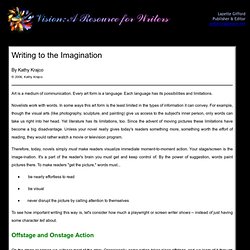
Every art form is a language. Each language has its possibilities and limitations. Novelists work with words. In some ways this art form is the least limited in the types of information it can convey. Therefore, today, novels simply must make readers visualize immediate moment-to-moment action. Be nearly effortless to read be visual never disrupt the picture by calling attention to themselves To see how important writing this way is, let's consider how much a playwright or screen writer shows -- instead of just having some character tell about. Offstage and Onstage Action On the stage or screen we witness most of the story. Was Shakespeare lazy? So, on stage and screen, some scenes are left out for good storytelling reasons. How to Write a Synopsis of Your Novel. By Glen C.
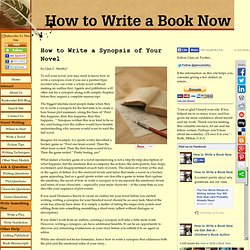
Strathy* To sell your novel, you may need to know how to write a synopsis, even if you are a pantser-type novelist who can write a whole novel without making an outline first. Agents and publishers will often ask for a synopsis along with sample chapters before they request a complete manuscript. The biggest mistake most people make when they try to write a synopsis for the first time is to create a bare bones plot summary, along the lines of “First this happens, then this happens, then this happens...” Synopses written this way tend to be so dry and boring even the author would have trouble understanding why anyone would want to read the full novel.
Imagine, for example, if a sports writer described a hockey game as “First one team scored. What makes a hockey game or a novel mesmerizing is not a step-by-step description of what happens, but the emotions that accompany the actions, the anticipation, fear, hope, excitement, and disappointment at each turn of events.